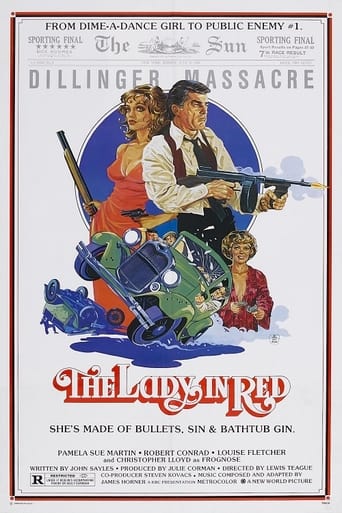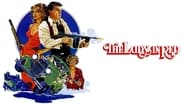Woodyanders
Sweet and resourceful farm girl Polly Franklin (delightfully played with infectious charm and exuberance by the lovely Pamela Sue Martin) lives one hell of a lively, eventful, and exciting life in Chicago during the Great Depression of the 1930's: She starts out toiling away in a brutal sweatshop, works briefly as a dance hall girl, does a stretch in prison, gets forced into prostitution at a brothel after she's paroled from jail, and eventually secures a gig as a diner waitress prior to becoming the unsuspecting girlfriend of notorious, but gentlemanly criminal John Dillinger (a credible portrayal by Robert Conrad). Ably directed by Lewis Teague, with a sharp and compact script by John Sayles, a plausibly gritty, vivid, and unsentimental evocation of the period, a ceaseless brisk pace, a jaunty and flavorsome score by James Horner, coarse, crackling dialogue, startling outbursts of raw'n'brutal violence, bright, attractive cinematography by Daniel Lacambre, nice touches of dark humor, a handful of rousing action set pieces, and a generous amount of female nudity, this film manages to effectively transcend its modest B-flick exploitation origins on the strength of its extremely absorbing story, plenty of surprisingly astute and insightful social observations on race, sex, and class, and a hugely sympathetic and strong-willed main character who engages audience interest throughout. Kudos are also in order for the uniformly fine acting from a sterling cast, with especially praiseworthy work by Louise Fletcher as tough, classy, and cagey madam Anna Sage, Robert Hogan as sleazeball newspaper reporter Jake Lingle, Laurie Heineman as Polly's feisty best gal pal Rose Shinkus, Glenn Withrow as eager kid Eddie, Christopher Lloyd as nasty, disfigured mobster Frognose, Nancy Parsons as vicious prison warden Tiny Alice, Alan Vint as top G-man Melvin Purvis, and Dick Miller as slimy and despicable sweatshop manager Patek. Robert Forster has a sizable uncredited role as suave and affable hit-man Turk. Popping up in neat bits are Mary Woronov as a gun moll and Michael Cavanaugh as an undercover vice cop. An immensely worthwhile and enjoyable picture.
Igenlode Wordsmith
This picture makes for an interesting companion piece to Michael Mann's recent "Public Enemies"; it covers not only the same era and the same setting but, inevitably, much of the same source material. And compared to earlier black-and-white gangster movies it shares a similar distinctly modern sensibility. Indeed, dubbed a "cheerful exploitation flick", it far outdoes the more recent film in the sheer quantity of sex and nudity on display. Yet oddly enough it manages to avoid the impression of gratuitous indulgence: the lolling female flesh on view is treated as more matter-of-fact (sometimes grotesque) than erotic, and the explicit violence is never casually treated."The Lady in Red" turns out to succeed on a number of levels where "Public Enemies" failed: above all and most vitally in characterization and plot development. We actually care what becomes of the heroine and those she meets, however lurid the scenarios that ensue. Individuals are vividly drawn and memorable, and a vein of black humour periodically enlivens the script; it even conjures up some moments of almost lyrical happiness to provide a far more convincing love affair than Mann can achieve. Every victory over tyranny may seem to leave Polly in the long term worse off, and yet we cheer fiercely at her rebellion. There is no lack of audience identification here.The film is also surprisingly sure-footed in its period setting. After the initial reflex jolt at seeing the familiar monochrome settings re-enacted in colour -- unthinking: of course in reality the colour would always have been there, it's just that we never saw it -- "Lady in Red" pulls off the rare trick of presenting a world that seems entirely natural to its era. The cars are not conscious museum pieces, the clothes are not being worn as costumes, the props are not just set dressing: 'period' productions so often give the air of having tried too hard over every glossy detail, or else of importing a patronising grime of deprivation. This one seems to do neither. It even gets away with the potentially heavy-handed use of period cultural references (Elliot Ness, King Kong). After a while -- the ultimate accolade -- you forget that it's in colour.And finally, despite an escalating violence/body count, this film manages to retain death to genuinely shocking effect. There are no diminishing-return shots of gun porn here; no five-minute jerking, numbing sprays of muzzle-flash after dark. (And, although it had not until now occurred to me, no cars that roll over and burst into flames...) A lot of people wind up dead one way or another: but seen through Polly's eyes, it is neither cheap entertainment nor taken for granted.Acting performances are admirable all round in both major and minor roles. The use of music, in particular the evocative "42nd Street" as general theme to the picture in changing moods for each context, is excellently done. This isn't the sort of picture I would have anticipated liking -- the breast count alone is about fifty times greater than anything I'd normally see -- but I found it quite unexpectedly successful... and, I'm afraid, superior on every level to "Public Enemies", with which it has on the surface so much 'modernity' in common.
grahamsj3
I first saw this film on TV and with the commercial breaks, it suffered. However, I later saw it without the commercials and it's so much better. It's the story of Gangster John Dillenger and his last girlfriend. Pamela Sue Martin as the moll and Robert Conrad as Dillenger both deliver great performances. I don't know much about John Dillenger, but I wonder if he was as "gentlemanly" as Conrads' portrayal was. Just a thought! However, it is a strong story, with enough violence to be realistic (those were violent times). There's also the romantic element that gives a softness to Dillenger. As I said, I wonder if he was a romantic at all. Anyway, a decent enough flick and well-acted.
rlcsljo
If they had called it "The life of a Gun Moll", nobody probably would have gone to see it. So they went with the Dillinger angle, but forget it this is Pamela Sue's film.If you ever wondered how "good little" girls end up being window dressing for some of the most notorious gangsters that ever lived, this film gives a good look at her rebellion against her strict religious up bringing and her descent into crime and prostitution.Pamela Sue is so cute, you have a hard time believing she is a hardened criminal, but she just about pulls it off.





